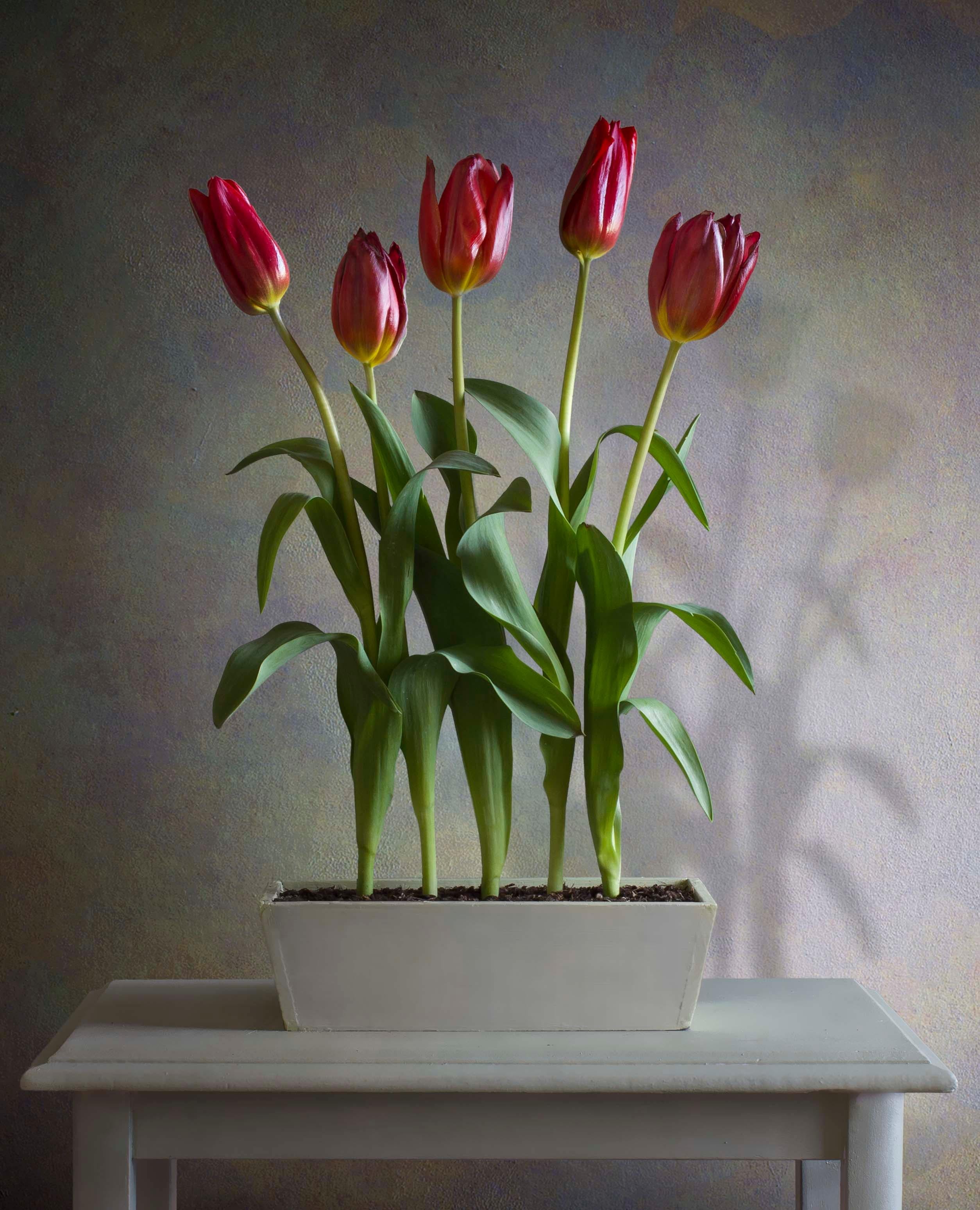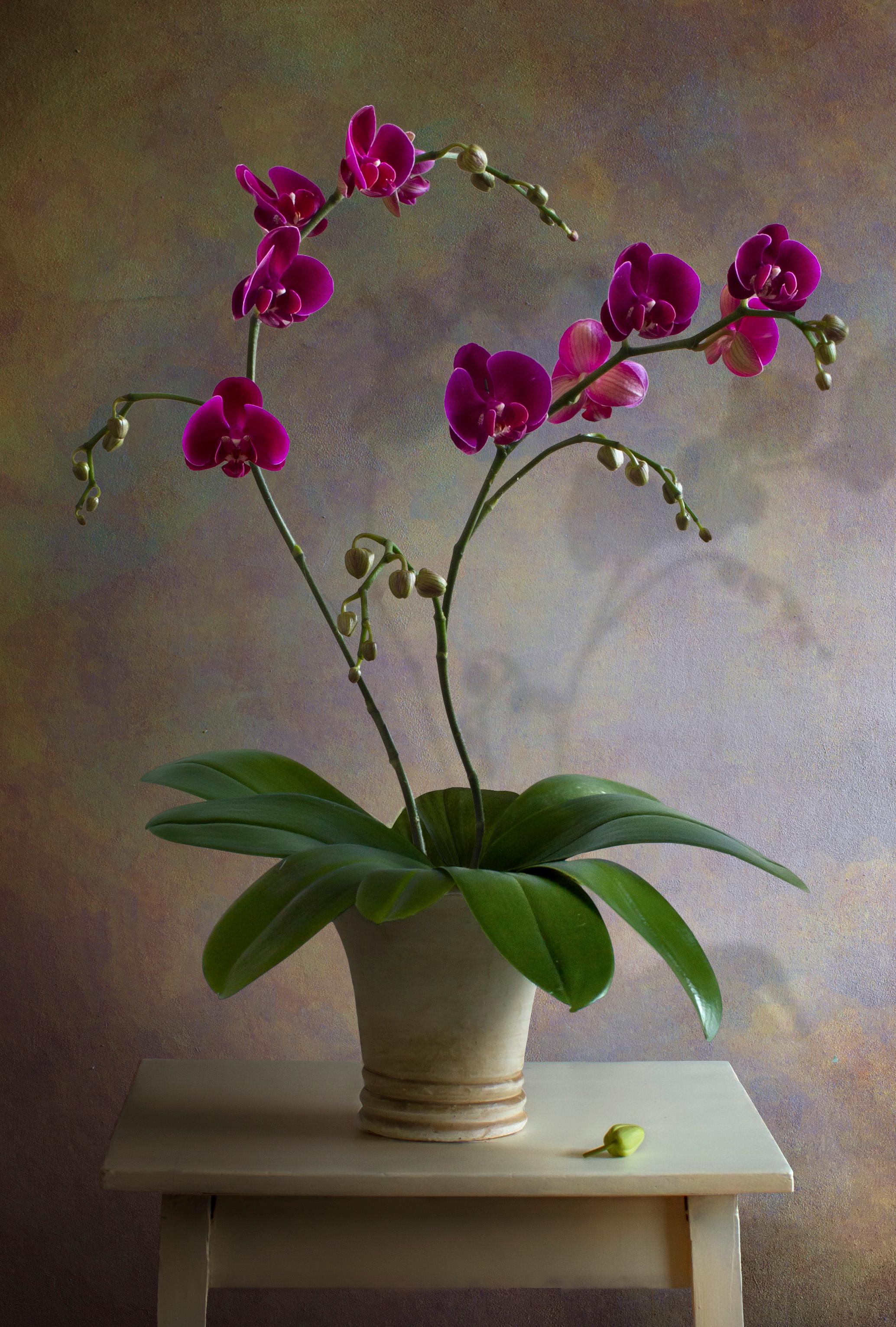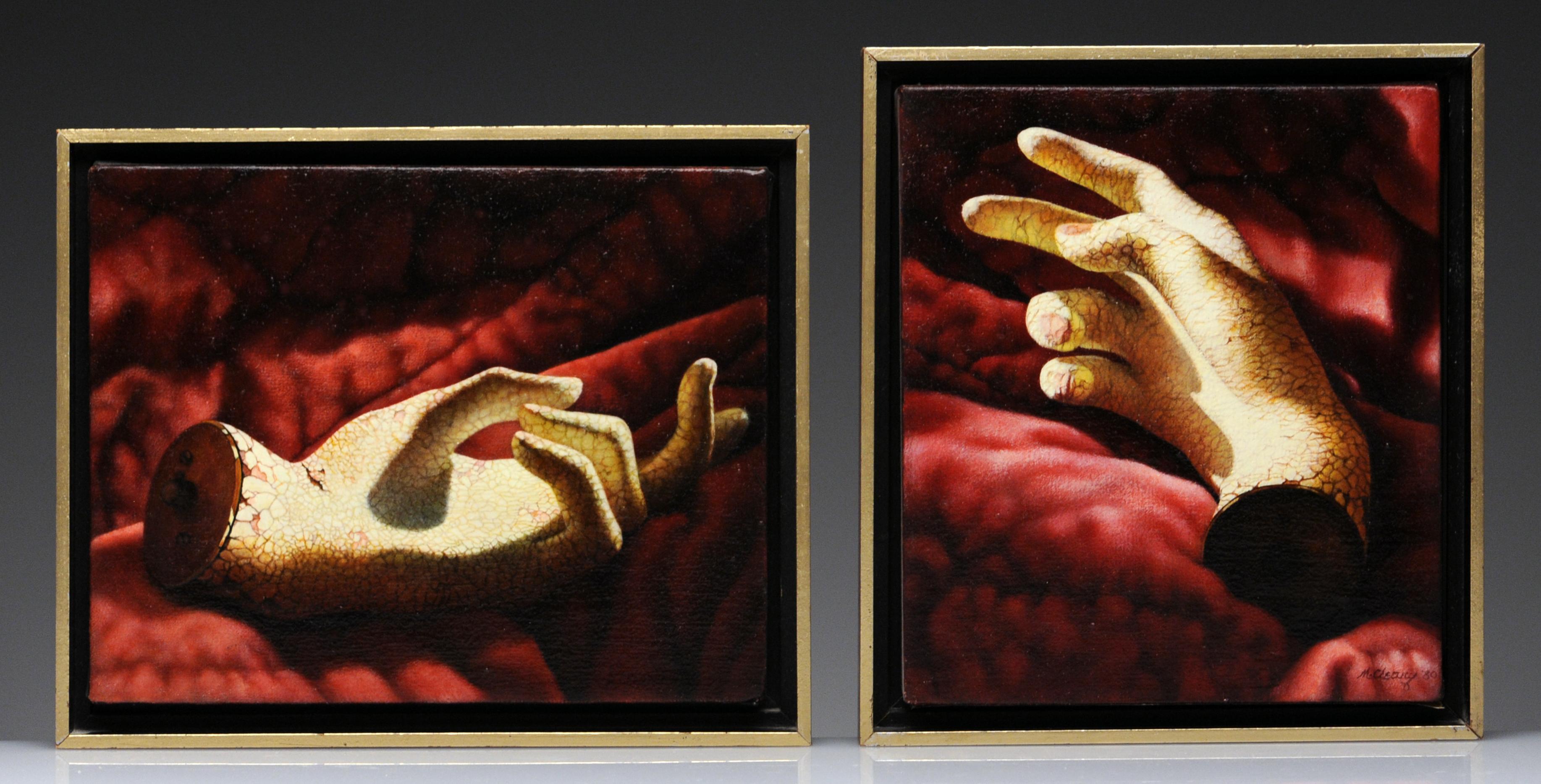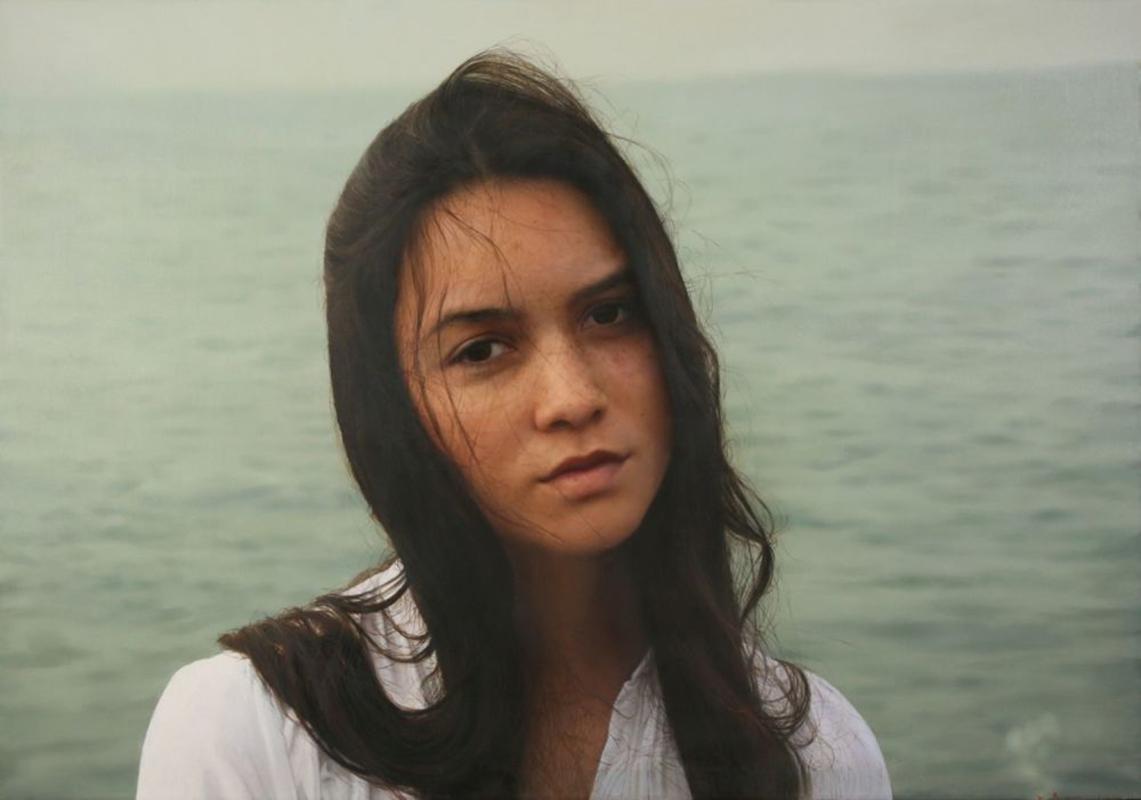Items Similar to Bark HESPER Unloading Lumber at San Diego
Want more images or videos?
Request additional images or videos from the seller
1 of 9
David ThimganBark HESPER Unloading Lumber at San DiegoDated 2002
Dated 2002
About the Item
This bright and serene scene of ships unloading off San Diego, California features a ship with a less than quiet history. The painting shows a typically bright and sunny Southern California day, the deep blue waters of San Diego providing the perfect backdrop for unloading crucial lumber for construction. The painting has Thimgan's eye for detail including the historic ship he's depicted, surely with a knowledge of her history, and his ability to so perfectly depict California's coastal landscape and surrounding waters.
Some ships of legend get their reputations not for speed or daring rescues, but for the amount of chaos which happens onboard. Sailors, being generally a superstitious lot, could spread a ship's reputation like wildfire. As with the supposedly haunted places on land, the odd instances become larger tales whispered over strong drink in port or at worst, printed in bold newspaper headlines. The best crews don't want to serve aboard such vessels, so only the most hardened men sign on. Tempers flare and conditions deteriorate. Over time a ship gains the nickname of "hell ship" or "blood ship." This was the fate of the Bark HESPER.
HESPER was purpose built in 1882 for the Pacific "Triangle Trade" - carrying lumber to Australia, coal to Hawaii and sugar to California, though she took on other cargoes in her career. The wooden bark of 603 tons was built by the Halls Brothers Shipyard of Port Blakeley, Washington and she was unusually fast and beautiful for ships of her type with a finely carved figurehead which can be seen near the center of the painting.
For the ship's first seven voyages she operated peacefully for the Halls Yard under their partnership with a Captain Cygnus Ryder. When Ryder sold his interest in the ship to the Halls they put HESPER under the command of Captain J.F. Sodergren- a man known for high standards and getting the most out of ship and crew. Sodergren's Second Mate, Mr. Fitzgerald, was particularly known as a brute enforcer of discipline.
A March 1893 headline read, "MUTINY AND MURDER. Bloody Work on Board the Bark Hesper. A DARING PLOT FRUSTRATED." HESPER left NSW, Australia on December 22nd with a load of coal bound for San Francisco. Sodergren had just gotten married and not only was his new wife onboard but among the crew it was whispered that $20,000 was being transported in the ship's strongbox. A plot was hatched to steal both wife and cash.
Three weeks later, on January 13th, five of her crew attempted mutiny- hoping to do away with the Captain, mates and two other loyal crew, they would take control of the ship and sail to China or Chile, sell the cargo and outfit the ship for piracy. 2nd Mate Fitzgerald was ambushed on deck and fell to a galley hatchet but when Fitzgerald didn't call for relief at the end of his watch, the First Mate warned the Captain who went on deck, pistol at the ready. The plot relied upon ambush, so upon sight of the revolver the perpetrators surrendered to arrest. The ship rerouted to Tahiti and the men confessed before the US Consul Doty whereupon they were held until another ship could deliver them to a very public and famous trial in San Francisco and eventually up to the US Supreme Court. Three were convicted and one hanged.
You might think that with the poor treatment of sailors mutinies were common, but actually they were rare. Ship's officers had firearms and crews only knives and belaying pins. If a plot failed it was well known that the punishment for mutiny was hanging. So even though bad pay, short rations and poor treatment were common it often wasn't enough to make it worthwhile.
The publicized trial made HESPER notorious, and the gossip of the wharf took hold. Before long it was the ship itself, now said to be a haunted hell-ship, that was to blame. Later newspaper reports of the ship simply making port were accompanied by newspaper articles about the mutiny. The Halls found it impossible to get crews aboard her and once there to keep them from jumping ship. She was sold and transferred to British registry, but the new owners went bankrupt. The haunted reputation now firmly cemented, HESPER lay at anchor for three years before she was sold for a voyage to Chile with lumber and to seek treasure at Cocos Island. On the way she would end her career with another mutiny and sinking in shallow water off Peru.
Signed LL, Sight Size 15 x 30 inches
- Creator:David Thimgan (1955 - 2003, American)
- Creation Year:Dated 2002
- Dimensions:Height: 21 in (53.34 cm)Width: 36 in (91.44 cm)
- Medium:
- Movement & Style:
- Period:
- Condition:
- Gallery Location:Costa Mesa, CA
- Reference Number:1stDibs: LU2139211947612
About the Seller
No Reviews Yet
Vetted Seller
These experienced sellers undergo a comprehensive evaluation by our team of in-house experts.
Established in 1972
1stDibs seller since 2022
5 sales on 1stDibs
Typical response time: 1 to 2 days
- ShippingRetrieving quote...Ships From: Costa Mesa, CA
- Return PolicyA return for this item may be initiated within 7 days of delivery.
More From This SellerView All
- The Clipper FLYING FISH in San Francisco BayLocated in Costa Mesa, CAOne of the most exciting races between American clipper ships took place between October, 1852 and January, 1853. The vessels involved were the crack clippers FLYING FISH, JOHN GILPIN and WILD PIGEON. Departing New York, each a few days apart, the three ships met up off Cape Horn and proceeded, often in sight of one another, to fly up the west coast to San Francisco. The JOHN GILPIN gambled by heading farther west into the pacific where a strong northerly got her to San Francisco first. FLYING FISH and WILD PIGEON remained in sight of one another for most of the voyage in their dash up the coast. FLYING FISH arrived a day after GILPIN, but having left New York three days behind her adversary, was declared the winner. This view shows an excellent starboard view of the great FLYING FISH on her entry into San Francisco Bay. The water has superb light and reflection while the Marin headlands show as her backdrop, with the ever-present misty atmosphere of this important California port. A well captured moment of one of the fastest and most powerful 19th century great sailing ships created. Sight Size: 18 x 34 inches Vallejo Gallery...Category
1990s Paintings
MaterialsCanvas, Oil
- The Maryland Ship DEFENCE Chases the British Sloop OTTER Down Chesapeake BayBy Leslie Arthur WilcoxLocated in Costa Mesa, CAThis large and exciting scene features an American Revolutionary War battle in Chesapeake Bay. With great color and lively brushwork this painting was done at a large scale which captures a grand vista of the Bay along with many small vignettes to draw the eye. No less than ten other ships surround the two combatant vessels as they exchange cannon fire...Category
1970s Paintings
MaterialsCanvas, Oil
- At the Yacht ClubBy Edward CucuelLocated in Costa Mesa, CAArtist Edward Cucuel and his wife Clara Lotte von Marcard spent their first two decades together in Germany, mostly in a villa on Lake Ammersee in Holzhausen near Munich. It is the works created in this period, mainly outdoor scenes of young women in fashionable attire of the day, that are most collected and appreciated among his works. It’s easy to see why- they capture an elegance and sense of calm and easy leisure- of long days in gardens or by the water. This is one of those captured moments with a well-dressed woman watching the sailing yacht...Category
1920s Impressionist Landscape Paintings
MaterialsCanvas, Oil
- PURITAN vs GENESTA, America's Cup 1885By Edward MoranLocated in Costa Mesa, CAThis impressive painting by Edward Moran does justice to the epic America’s Cup Challenge of 1885. Moran’s point of view captures the day’s enormity to the world’s yacht racers and designers. This account portrays PURITAN’s second and decisive victory of the match on the 40-mile course, 20 miles leeward from the Sandy Hook Lightship and back. PURITAN reached the line a scant 1 minute 38 seconds in front, the closest margin of victory to date. Well publicized and awaited on both sides of the Atlantic, the race held the public’s interest while knowledgeable yachtsmen waited to see if Boston’s Edward Burgess had innovated the centerboard sloop design to a degree capable of holding off the challenge of a true English cutter. GENESTA was designed by John Beavor-Webb, for her owner, Sir Richard Sutton...Category
1880s Paintings
MaterialsCanvas, Oil
- Solent Ones Rounding the Lepe MarkBy Montague DawsonLocated in Costa Mesa, CASolent One Racers cut across the rolling waves in this striking work by master maritime artist Montague Dawson. These are racing on the Solent, the strait between the Isle of Wight and the English mainland. The Solent One Design was one of the first One Design classes created. 22 were built between 1896 and 1897 for members of the Royal Yacht Squadron and the Island Sailing Club. Here, there is a fair wind...Category
1950s Paintings
MaterialsCanvas, Oil
- Napoleonic War Battle of Pulo AuraLocated in Costa Mesa, CAThis large and epic battle scene commemorates one of the most unusual actions of the Napoleonic Wars. The British Honourable East India Company’s China...Category
Early 1800s Paintings
MaterialsCanvas, Oil
You May Also Like
- Albert Benaroya (Israeli), Red Tulipss, oil on canvas, 81x56 cmBy Albert BenaroyaLocated in Jerusalem, ILAlbert Benaroya (Israeli) Red Tulips oil on canvas 81x56 cm Born in Istanbul, Benaroya is an Israeli artist, a master of depiction in hyper - realism...Category
2010s Photorealist Still-life Paintings
MaterialsCanvas, Oil
- Albert Benaroya (Israeli), Red an Purple Orchids, oil on canvas, 81x56 cmBy Albert BenaroyaLocated in Jerusalem, ILAlbert Benaroya (Israeli) Red an Purple Orchids oil on canvas 81x56 cm Born in Istanbul, Benaroya is an Israeli artist, a master of depiction in hype...Category
2010s Photorealist Still-life Paintings
MaterialsCanvas, Oil
- Diptych Hand PaintingsBy Manon ClearyLocated in Washington, DCExceptional pair of paintings by Manon Cleary (1942-1911). Paintings are oil on canvas. Dated 1980 and signed in the front lower right corner and on reverse. Manon Cleary's work is ...Category
1980s Photorealist Figurative Paintings
MaterialsCanvas, Oil
- Manon Cleary "Rat"By Manon ClearyLocated in Washington, DCPhotorealist oil painting by Manon Cleary (1942-2011). Painting is signed on reverse "Cleary". Painting is stretched on aluminum stretcher and dates to the 1990s. Manon Cleary had a remarkable ability to draw and paint with photographic fidelity, but she was also known as a charismatic teacher at the University of the District of Columbia and as a free spirit whose exuberant life may have been her most enduring work of art. Since the 1970s, Ms. Cleary had been at the center of a group of artists in Adams Morgan. She exhibited her meticulous artwork throughout the city and around the world, but she also became known for her striking presence, her colorful love life and the rats she kept as pets. As an artist, Ms. Cleary borrowed classical techniques from her deep study of Renaissance masters to create paintings and drawings memorable for their frank realism and sometimes disturbing themes. In addition to her many nude self-portraits, Ms. Cleary made erotically charged paintings of flowers. She took inspiration from a painful personal history in a series of works depicting the terror of rape and, in later years, of not being able to breathe without mechanical assistance. Critics considered her a leading figurative artist of the photo-realist school, in which painters render their subjects with camera-like precision. In fact, Ms. Cleary occasionally won awards for photography when adjudicators didn’t realize her works were free-hand creations. She was “widely acknowledged to be among the best, if not the best, of the city’s figurative painters,” Washington Post critic Michael O’Sullivan wrote in 2006. “There is a tension between the cool, clinical detachment of photography and painting’s warm idealization of form.” Ms. Cleary exhibited her art in galleries and museums from Moscow to Paris to Hickory, N.C., but Washington was her home for the past 42 years. In 1974, she settled in the decrepit Beverly Court apartments on Columbia Road NW, where a coterie of artists soon grew up around her. She painted her walls purple, and her fourth-floor apartment — even with the pet rats — became something of a bohemian salon. “She was a star,” painter Judy Jashinsky told the Washington City Paper in 2004. “She was stunning, beautiful; long, brownish–black hair; real thin; wore . . . little sundresses and sandals. She was just very cool, and there was always a crowd around her.” Ms. Cleary had a long list of male admirers, including several whose confrontational attempts at “performance art” led to their arrests. She had a brief marriage in 1981 to a Danish artist known as Tommy — “just Tommy,” Ms. Cleary said — whom she divorced in less than a year. As a kind of graphic homage to her various lovers, Ms. Cleary made a series of intimately revealing portraits that were featured years later on the HBO program “Real Sex.” She met her second husband after a gallery opening in Baltimore. By way of introduction, Kijek, a dancer, stripped naked at a crowded party, walked up to Ms. Cleary and said, “Wouldn’t you like me to pose for you?” They were married in 2001. In spite of her unconventional life, Ms. Cleary was more than a mere provocateur. After a day of teaching at UDC, she would return to her studio, with its windows painted over to block out sunlight, and work late into the night, with a bottle of Dr Pepper at her side. She took nude photographs of herself from every angle, then painstakingly created lifelike images that seemed alive with the warmth of human flesh. After studying in Rome in her youth, she developed what she called “an obsession” with Caravaggio, an iconoclastic painter who lived from 1573 to 1610. She often copied paintings at the National Gallery of Art and, in her own work, blended Renaissance styles with a distinctly modern sensibility. Manon Catherine Cleary was born Nov. 14, 1942, in St. Louis. Her father was a doctor, and her identical twin sister, Shirley Cleary-Cooper, is an artist in Helena, Mont. She was a 1964 graduate of Washington University in her home town and, for the rest of her life, was proud of having been a member of the Pi Phi...Category
1990s Photorealist Animal Paintings
MaterialsOil, Canvas
- GirlBy Yigal OzeriLocated in Jerusalem, ILA breathtaking oil painting by Israeli Born-New York based artist Yigal Ozeri. This hyperrealist portrait of a young girl staring back at her viewer, is a classic example of the arti...Category
1990s Photorealist Portrait Paintings
MaterialsCanvas, Oil
- Lila, first snow, orange chromeLocated in Las Vegas, NVPortrait of Lila, oil on canvas 47 3/4 in x 31 in 2015Category
2010s Photorealist Portrait Paintings
MaterialsCotton Canvas, Oil





